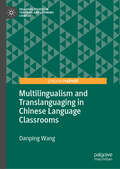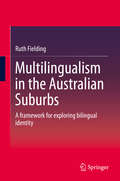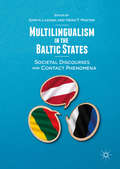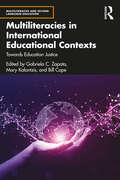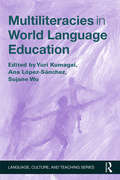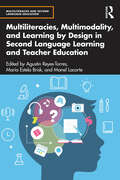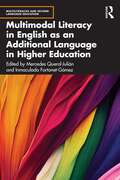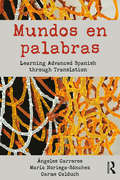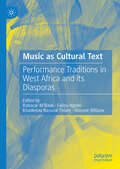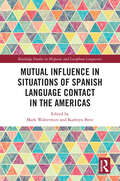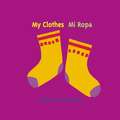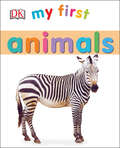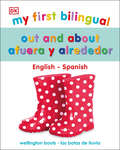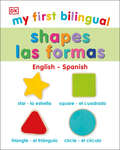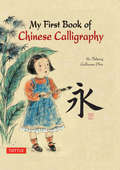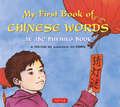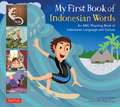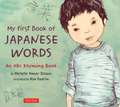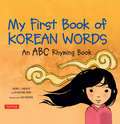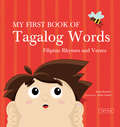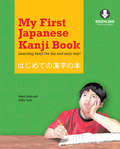- Table View
- List View
Multilingualism and Translanguaging in Chinese Language Classrooms (Palgrave Studies in Teaching and Learning Chinese)
by Danping WangThis book presents new research on Chinese as a Second Language (CSL) teaching from an ethnographic classroom study on classroom translanguaging practices that highlights the policy and pedagogical implications of adopting a creative and principled multilingual approach. Drawing on a case study from Hong Kong, it analyses naturally observed language patterns in CSL classrooms and the attitudes of students and teachers towards prescribed classroom language policies, and thereby demonstrates the importance of mixing Chinese, English and students’ home languages to achieve successful second language learning. It discusses the nature and guiding principles for classroom translanguaging research and provides research tools that will enable second language teachers to examine their own language practices. The author argues persuasively that second language teaching practices and policies must reflect the current reality of language use and the diverse learning needs of multilingual students. This book will appeal to teacher educators and researchers in fields such as second language acquisition, foreign language teaching and language policy.
Multilingualism in the Australian Suburbs
by Ruth FieldingThis book introduces a framework for examining bilingual identity and presents the cases of seven individual children from a study of young students' bilingual identities in an Australian primary school. The new Bilingual Identity Negotiation Framework brings together three elements that influence bilingual identity development - sociocultural connection, investment and interaction. The cases comprise individual stories about seven young, bilingual students and are complemented by some more general investigations of bilingual identity from a whole class of students at the school. The framework is explained and supported using the students' stories and offers readers a new concept for examining and thinking about bilingual identity. This book builds upon past and current theories of identity and bilingualism and expands on these to identify three interlinking elements within bilingual identity. The book highlights the need for greater dialogue between different sectors of research and education relating to languages and bilingualism. It adds to the increasing call for collaborative work from the different fields interested in language learning and teaching such as TESOL, bilingualism, and language education. Through the development of the framework and the students' stories in this study, this book shows how multilingual children in one school in Australia developed their identities in association with their home and school languages. This provides readers with a model for examining bilingual identity in their own contexts, or a theoretical construct to consider in their thinking on bilingualism, language and identity.
Multilingualism in the Baltic States: Societal Discourses And Contact Phenomena
by Heiko F. Marten Sanita LazdiņaThis edited collection provides an overview of linguistic diversity, societal discourses and interaction between majorities and minorities in the Baltic States. It presents a wide range of methods and research paradigms including folk linguistics, discourse analysis, narrative analyses, code alternation, ethnographic observations, language learning motivation, languages in education and language acquisition. Grouped thematically, its chapters examine regional varieties and minority languages (Latgalian, Võro, urban dialects in Lithuania, Polish in Lithuania); the integration of the Russian language and its speakers; and the role of international languages like English in Baltic societies. The editors’ introductory and concluding chapters provide a comparative perspective that situates these issues within the particular history of the region and broader debates on language and nationalism at a time of both increased globalization and ethno-regionalism. This book will appeal in particular to students and scholars of multilingualism, sociolinguistics, language discourses and language policy, and provide a valuable resource for researchers focusing on Baltic States, Northern Europe and the post-Soviet world in the related fields of history, political science, sociology and anthropology.
Multiliteracies in International Educational Contexts: Towards Education Justice (Multiliteracies and Second Language Education)
by Bill Cope Mary Kalantzis Gabriela C. ZapataMultiliteracies in International Educational Contexts: Towards Education Justice examines how multiliteracies and Learning by Design have been taken up across international second-language instructional contexts, with a focus on inclusive practices and social justice. This edited collection brings together a team of international contributors to offer a global perspective on the application of multiliteracies in L2 education. Through the analysis of classroom-based qualitative and quantitative data on different aspects of the multiliteracies pedagogy, the book shows how the multiliteracies pedagogy can facilitate more inclusive practices while providing suggestions for pedagogical interventions and future research. This book will be a key resource for language educators, researchers, and practitioners interested in the multiliteracies pedagogy, as well as those interested in critical and social justice approaches to language teaching.
Multiliteracies in World Language Education (Language, Culture, and Teaching Series)
by Yuri Kumagai Ana López-Sánchez Sujane WuPutting a multiliteracies framework at the center of the world language curriculum, this volume brings together college-level curricular innovations and classroom projects that address differences in meaning and worldviews expressed in learners’ primary and target languages. Offering a rich understanding of languages, genres, and modalities as socioculturally situated semiotic systems, it advocates an effective pedagogy for developing learners’ abilities to operate between languages. Chapters showcase curricula that draw on a multiliteracies framework and present various classroom projects that develop aspects of multiliteracies for language learners. A discussion of the theoretical background and historical development of the pedagogy of multiliteracies and its relevance to the field of world language education positions this book within the broader literature on foreign language education. As developments in globalization, accountability, and austerity challenge contemporary academia and the current structure of world language programs, this book shows how the implementation of a multiliteracies-based approach brings coherence to language programs, and how the framework can help to accomplish the goals of higher education in general and of language education in particular.
Multiliteracies, Multimodality, and Learning by Design in Second Language Learning and Teacher Education (Multiliteracies and Second Language Education)
by Manel Lacorte María Estela Brisk Agustín Reyes-TorresMultiliteracies, Multimodality, and Learning by Design in Second Language Learning and Teacher Education offers valuable insights and practical strategies for addressing the language and literacy needs of students in diverse, multilingual classrooms. This edited volume delves into the dynamic interplay between multimodality, multiliteracies, and Learning by Design (LbyD), providing evidence-based research and actionable guidance for their effective implementation in second language learning and teacher education. Examining the advantages of incorporating multimodality and multiliteracies in second language teacher training, this book emphasizes the use of multimodal texts to create engaging and meaningful lessons for L2 learners. By empowering students as active co-constructors of knowledge, this book equips educators with the necessary tools to foster a vibrant and inclusive learning environment. Designed specifically for pre-service and practicing teachers, this book serves as an indispensable resource for integrating the pedagogy of multiliteracies into both coursework and classroom practices.
Multimodal Funds of Knowledge in Literacy: Countering Deficit Narratives of Diverse Families
by Sally Brown Rong ZhangApplying an asset-based approach, Multimodal Funds of Knowledge in Literacy prepares educators to teach and support diverse students and their families as they negotiate multimodal aspects of literacy learning. Framed by sociocultural theory, multiliteracies, multimodality, and posthumanism, the text combats deficit narratives by providing concrete alternatives that push educators to rethink their practices and support students’ and families’ cultural and linguistic strengths.Chapters include case studies, vignettes, prompts, and learning samples that will leave readers with valuable insights and new understandings of multimodal funds of knowledge. Comprehensive and instructive, this book is a key text in literacy education, family literacy, and community engagement.
Multimodal Literacy in English as an Additional Language in Higher Education (Multiliteracies and Second Language Education)
by Gabriela C. Zapata Inmaculada Fortanet-Gómez Mercedes Querol-JuliánMultimodal Literacy in English as an Additional Language in Higher Education addresses three key aspects of multimodal literacy in higher education: identifying what is understood by multimodal literacy, its teachability in the EAL context, and how to integrate multimodal competence into professional development programmes.This edited collection provides a diverse and international perspective on multimodal literacy development in both students and teachers in higher education settings. The volume is organised into three parts: the first examines the concept of multimodal literacy at university level from different perspectives; the second focuses on students, with examples of how multimodal literacy pedagogies in EAL courses can be meaningfully applied; and the third explores the design and implementation of EAL teachers’ professional development programmes which promote and enhance multimodal literacy. Multimodal Literacy in English as an Additional Language in Higher Education paves the way for the integration of multimodal literacy theories and practices in the different EAL curricula.This innovative volume brings together both theory and practical application and is essential reading for researchers, postgraduate students, and teachers and teacher trainers in the fields of language teaching, language learning, and education.
Mundos en palabras: Learning Advanced Spanish through Translation
by Ángeles Carreres María Noriega-Sánchez Carme Calduch<p>Mundos en palabras offers advanced students of Spanish a challenging yet practical course in translation from English into Spanish. <p>The course provides students with a well-structured, step-by-step guide to Spanish translation which will enhance and refine their language skills while introducing them to some of the key concepts and debates in translation theory and practice. <p>Each chapter presents a rich variety of practical tasks, supported by concise, focused discussion of key points relating to a particular translation issue or text type. Shorter targeted activities are combined with lengthier translation practice. Throughout the book, learners will find a wealth of material from a range of genres and text types, including literary, expository, persuasive and audiovisual texts. An answer key to activities, as well as supplementary material and Teachers’ Notes are provided in the companion website. <p> <p>The book covers common areas of difficulty including: <li>frequent grammatical errors <li>calques and loan words <li>denotation and connotation <li>idioms <li>linguistic varieties <li>cultural references <li>style and register</li> <p> <p>Suitable both for classroom use and self-study, Mundos en palabras is ideal for advanced undergraduate students of Spanish, and for any advanced learners wishing to acquire translation competence while enhancing their linguistic skills.</p>
Music as Cultural Text: Performance Traditions in West Africa and its Diasporas
by Fallou Ngom Babacar M’Baye Khadimou Rassoul Thiam Alioune WillaneAfrican music&’s most distinctive feature is the urbatextuality that transpires through its diversity and plural functions and the specific geographical, cultural, religious, linguistic, political, economic, and social contexts from which it evolves. This music and its circum-Atlantic offspring are characterized by wisdom, subtlety, resilience, and creativity. They are cultural texts marked by an openness to other customs and societies since they maintain authenticity that does not foreclose hybridity, cosmopolitanism, and other global human sensibilities. These elements have made West African music a transnational commodity and a source of inspiration and survival both on the continent and in the black diaspora. Such patterns characterize Pan-African musical traditions that thrive in several spaces where both plurality and authenticity are welcome. These characteristics are apparent in rich, complex, and vibrant musical cultures such as rap in Senegal, France, and Burkina Faso, Malian traditional music in Canada and France, hip-life and hip-hop in Ghana, Christian songs in Ghana and Nigeria, and ngoyaan, Cape Verdean cabo, and zouk in Senegal. African music&’s distinctive features are also noticeable in Niger&’s guitar-playing traditions and Tuareg oral poetry as well as in Senegambian blues that influenced their African American offspring whose imprints they bear. By exploring all these elements, the chapters in this book pay homage to the heterogeneity, memories, hope, pain, and humanity in the music of Africa and the black diaspora.
Mutual Influence in Situations of Spanish Language Contact in the Americas (Routledge Studies in Hispanic and Lusophone Linguistics)
by Mark Waltermire and Kathryn BoveMutual Influence in Situations of Spanish Language Contact in the Americas focuses on the structural results of contact between Spanish and Maya, Quechua, Guaraní, Portuguese, and English in the Americas. This edited volume explores the various ways in which these languages affect the linguistic structure of Spanish in situations of language contact, and also how Spanish impacts their linguistic structure. Across ten chapters, this book offers a broad survey of bidirectional influence in Spanish contact situations both geographically (in the US Southwest, the Yucatán Peninsula, the Andean regions of Ecuador and Peru, and the Southern Cone) and structurally (in the areas of phonetics, phonology, morphosyntax, semantics, and pragmatics). By examining the potential structural effects that two languages have on one another, it provides a novel and more holistic perspective on mutual linguistic influence than that of previous work on language contact. The volume serves as a reference on mutual influence in bilingual language varieties and will be of interest to researchers, scholars and graduate students in Hispanic linguistics, and more broadly in language contact.
My Clothes (Mi Ropa)
by Rebecca EmberleySocks, shoes, pants, shirts--all types of clothes appear in bright, bold pictures in this Spanish/English board book that helps the youngest of readers learn simple words in another language.
My Family is Special to Me/Kuv tsev neeg zoo tshwj xeeb rau kuv
by Bao XiongLearn what one girl's family consists of and how much she loves them. In English and Hmong.
My First Animals (My First Board Books)
by DKHelp your toddler learn all about animals in My First Animals. From tiny insects and huge bears to stripy animals and sea creatures My First Animals helps your toddler explore the wild world of creatures big and small. Each page introduces a new animal group such as farm animals or baby animals to keep early learning simple and fun. With 16-pages of colorful, bright photographs alongside clear word-labels your little one will know their beasties from their butterflies in no time. Perfect for encouraging children to build vocabulary and language skills My First Animals helps toddlers grasp early concepts. Your little one will love discovering the animal kingdom. Read it together and help them learn about the animal world.
My First Bilingual Out and About / Fuera y sobre (My First Board Books)
by DKDK's most successful board book series is now bilingualWith its simple point-and-say layout, My First Bilingual Out and About builds confidence through repetition and encourages preschool vocabulary and language skills in Spanish and English.Preschoolers can learn about all the places they might visit, in this informational board book featuring images of the playground, the supermarket, the doctor's office, a birthday party, and more. Designed to withstand wear and tear from your toddler, this board book is specially designed to captivate young readers. With bright, bold, and colorful photographs on white backgrounds, this book creates a foundation for learning:- Interesting subject (the world outside the home and places to visit) promotes reading readiness- Bilingual text promotes familiarity in both languages- Naming pictures develops key observational skills- Photographic content builds knowledge of the worldAbout the series: DK's most successful board book series includes fresh photography, contemporary design, and an insightful approach to engaging preschoolers. With charming, bold design, clear labels, and a wide variety of topics, these first learning books encourage children to build the vocabulary and language skills that form the foundation of early education, and are now available in bilingual editions.
My First Bilingual Shapes / Formas (My First Board Books)
by DKDK's most successful board book series is now bilingualWith its simple point-and-say layout, My First Bilingual Shapes builds confidence through repetition and encourages preschool vocabulary and language skills in Spanish and English.Preschoolers can learn about all different shapes in this informational board book featuring images of triangles, rectangles, stars, hearts, and more, and including a toy train scene with all the shapes called out. Designed to withstand wear and tear from your toddler, this board book is specially designed to captivate young readers. With bright, bold, and colorful photographs on white backgrounds, this book creates a foundation for learning:- Accessible subject (shapes and how familiar objects can be categorised by shape) promotes reading readiness- Bilingual text promotes familiarity in both languages- Naming pictures develops key observational skills- Photographic content builds knowledge of the world- Tracing with fingers along dotted lines develop motor skillsAbout the series: DK's most successful board book series includes fresh photography, contemporary design, and an insightful approach to engaging preschoolers. With charming, bold design, clear labels, and a wide variety of topics, these first learning books encourage children to build the vocabulary and language skills that form the foundation of early education, and are now available in bilingual editions.
My First Book of Chinese Calligraphy
by Guillaume Olive Zhihong HeMy First Book of Chinese Calligraphy is a fun and engaging introduction to one of China's most popular arts and crafts for kids. <P><P>Calligraphy-the art of producing decorative handwriting or lettering with a pen or brush-has been around for thousands of years. In this book, readers will follow along with Mimi who takes her first steps towards learning this magical art. Dive in, and explore:The Evolution of Chinese Writing-how Chinese characters first began, thousands of years ago, and how they have evolvedThe Order of the Strokes-learn how to write the strokes in the correct orderThe Four Treasures of Calligraphy- the four essential tools to get startedMovements and Position-how to master your mind's focus, your breathing and even how to moveThe Five Styles of Calligraphy-Zhuan Shu (seal), Li Shu (clerical), Kai Shu (regular), Cao Shu (cursive), and Xing Shu (running)The Eight Strokes- how to draw the 8 strokes; with them, you can write anythingWriting a Character in Calligraphy-create an entire character in calligraphyThe included interactive CD-ROM enables learners to play creative games to see, hear and try Chinese writing; listen to the pronunciation of the Chinese characters; observe calligraphers in action and print the characters to create practice pages.
My First Book of Chinese Words
by Faye-Lynn Wu Aya Padrón"Z is for zàijiàn. "Goodbye!" we say- more good times together when we meet another day."My First Book of Chinese Words introduces Chinese language to preschool children in a gentle, playful way. The ABC structure provides a familiar framework that encourages fun and easy learning. The everyday words presented in this book include many that have special significance in Chinese culture. Each word is presented in Chinese characters (both Simplified and Traditional) as well as in Romanized form (Pinyin). Cultural and linguistic notes enhance the learning experience. And kids will love the wonderful Chinese family, beautifully illustrated in gentle colors, who will take them from page to page!
My First Book of Chinese Words
by Faye-Lynn Wu Aya PadrónMy First Book of Chinese Words introduces young children to basic words and concepts in the Chinese language through colorful rhymes and beautiful imagery. It is a book that parents and young children will enjoy reading together. The Chinese words in the book are all common, everyday items and the rhymes are informative and fun for children.The goal of My First Book of Chinese Words is to familiarize children with the basic sounds and written characters of Chinese; to introduce core concepts of Chinese culture and to illustrate the ways in which Chinese sounds differ from English ones. Teachers and parents will welcome the cultural notes at the back of the book and appreciate how the book is organized using a familiar ABC structure. Each word is presented in Chinese characters (both Simplified and Traditional) as well as Romanized Pinyin for easy pronunciation.With the help of this book, we hope more children (and adults) will soon join the more than one billion people worldwide who speak Chinese!
My First Book of Indonesian Words: An ABC Rhyming Book of Indonesian Language and Culture
by Linda Hibbs Julia LaudMy First Book of Indonesian Words introduces Indonesian language and culture to young children in a fun, playful way. <P><P> The familiar ABC rhyming structure combines with sparkling illustrations to encourage the natural ability of children to pick up new languages and vocabulary quickly. Words for things kids already know in English are joined by words specific to Indonesia, giving kids a glimpse into Indonesian life and culture. Everyday expressions--like "Apa kabar?" which means "How are you?"--give kids a chance to communicate in a meaningful way and show them that when it comes to courtesy and friendliness, other cultures have a lot in common with their own. Cultural and linguistic notes are added for the parents to enhance the Indonesian learning experience. The cheerful illustrations depict a friendly and culturally rich nation, where the people are happy to know you and to share a bit of who they are and how they live.
My First Book of Japanese Words: An ABC Rhyming Book
by Aya Padrón Michelle Haney BrownMy First Book of Japanese Words is a beautifully illustrated book that introduces young children to Japanese language and culture through everyday words.<P><P>The words profiled in this book are all commonly used in the Japanese language and are both informative and fun for English-speaking children to learn. The goals of My First Book of Japanese Words are multiple: to familiarize children with the sounds and structure of Japanese speech; to introduce core elements of Japanese culture; to illustrate the ways in which languages differ in their treatment of everyday sounds; and to show how, through cultural importation, a single word can be shared between languages.Both teachers and parents will welcome the book's cultural and linguistic notes, and appreciate how the book is organized in a familiar ABC structure. Each word is presented in Kanji (when applicable), Kana, and Romanized form (Romaji).With the help of this book, we hope more children (and adults) will soon be a part of the 125 million people worldwide that speak Japanese!
My First Book of Korean Words: An ABC Rhyming Book
by Aya Padron Henry J. Amen Kyubyong ParkMy First Book of Korean Words is a beautifully illustrated book that introduces young children to Korean language and culture through everyday words.The words profiled in this book are all commonly used in the Korean language and are both informative and fun for English-speaking children to learn. The goals of My First Book of Korean Words are multiple: to familiarize children with the sounds and structure of Korean speech; to introduce core elements of Korean culture; to illustrate the ways in which languages differ in their treatment of everyday sounds; and to show how, through cultural importation, a single word can be shared between languages.Both teachers and parents will welcome the book's cultural and linguistic notes, and appreciate how the book is organized in a familiar ABC structure. Each word is presented in Hangeul, as well as in its Romanized form.With the help of this book, we hope more children (and adults) will soon be a part of the nearly 80 million people worldwide that speak Korean!
My First Book of Tagalog Words
by Liana Romulo Jaime LaurelIn the age-old tradition of teaching language through rhyme and verse, My First Book of Tagalog Words introduces Philippine language and culture to preschool children in a playful and non-intimidating way. The ABC structure provides a familiar framework that encourages fun and easy learning. Its bold and bright illustrations aim to make children laugh and enjoy the learning process.
My First Book of Tagalog Words
by Liana Romulo Jaime LaurelIn the age-old tradition of teaching language through rhyme and verse, My First Book of Tagalog Words introduces Philippine language and culture to preschool children in a playful and non-intimidating way. The ABC structure provides a familiar framework that encourages fun and easy learning. Its bold and bright illustrations aim to make children laugh and enjoy the learning process.
My First Japanese Kanji Book: Learning Kanji the fun and easy way!
by Eriko Sato Anna Sato<P> My First Japanese Kanji Book is an inventive and unique introduction to kanji for children. Written by the mother-daughter team of Eriko and Anna Sato, this lovely book introduces 109 kanji characters to children with poems and illustrations. It includes all the Japanese Government specified first grade level kanji characters and a sprinkling of simple second to sixth grade characters. <P>The kanji are introduced in the context of 36 colorful paintings and poems by 14-year-old Anna Sato, herself a kanji learner. Each of the poems is presented in both Japanese and English, and all kanji are accompanied by furigana (small hiragana letters), stroke-order diagrams, sample vocabulary and boxes for writing practice. <P> A charming and educational volume, My First Japanese Kanji Book can be used as a self-study text, a supplementary material in Japanese language schools or a gift book for family or friends.
